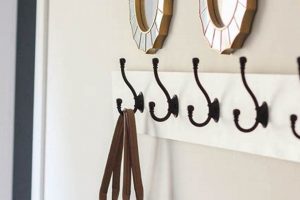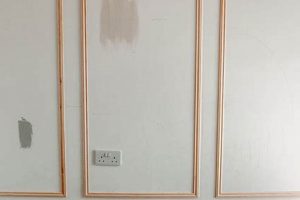A do-it-yourself project that transforms a standard wall surface into one capable of attracting and holding magnets allows for versatile displays and organization. This is achieved typically through the application of magnetic paint, magnetic primer, or adhered metal sheeting to a wall’s surface. For instance, a children’s playroom might benefit from this functionality, enabling the easy display of artwork or educational materials.
The creation of a magnet-receptive vertical surface offers several advantages. It provides a flexible and damage-free alternative to traditional hanging methods such as nails or tacks. This is particularly beneficial in rental properties or spaces where altering the walls is restricted. Historically, the concept of utilizing magnetic surfaces for display and organization has evolved from simple magnetic boards to integrated architectural elements, driven by a desire for adaptable and reusable display areas.
The subsequent sections will address the materials needed, the application process, alternative construction techniques, and considerations for choosing the most suitable method based on specific needs and project scope. Understanding these aspects ensures a successful outcome in creating a functional and aesthetically pleasing magnetic wall.
Essential Considerations for Magnetic Wall Creation
The following guidelines are designed to maximize the functionality and longevity of a self-installed magnetic wall.
Tip 1: Surface Preparation is Paramount: Ensure the wall surface is clean, smooth, and free of imperfections. Filling holes, sanding rough areas, and applying a primer coat contribute to optimal adhesion and a visually appealing final product.
Tip 2: Multiple Coats of Magnetic Paint are Necessary: Achieving sufficient magnetic strength typically requires at least three coats of magnetic paint. Allow each coat to dry thoroughly before applying the next, following the manufacturer’s instructions regarding drying times.
Tip 3: Consider Magnet Strength: Evaluate the weight and size of items intended for display. Stronger magnets or increased layers of magnetic material may be necessary to support heavier objects effectively.
Tip 4: Test Magnetic Attraction: Before applying a final topcoat of paint, test the magnetic strength across the entire surface. This allows for identification and correction of areas with insufficient magnetic pull.
Tip 5: Use a High-Quality Topcoat: Select a topcoat that is compatible with the magnetic paint or primer used. A durable topcoat protects the magnetic layer and provides a cleanable surface.
Tip 6: Metal Sheet Installation Requires Precision: When using metal sheeting, ensure precise measurements and smooth application to avoid bubbles or wrinkles. Use appropriate adhesive and secure the edges for long-term stability.
Tip 7: Prioritize Safety: Wear appropriate protective gear, such as gloves and a mask, during the application process. Ensure adequate ventilation, especially when working with magnetic paint or strong adhesives.
These considerations enhance the performance and aesthetic appeal of a magnet-receptive wall, ensuring it serves its intended purpose effectively. By meticulously planning and executing the project, individuals can create a durable and versatile display surface.
The subsequent sections will explore various design applications and alternative uses for magnetic walls, highlighting their adaptability in different environments.
1. Surface Preparation
Surface preparation forms the bedrock upon which a functional and aesthetically pleasing magnet-receptive wall is built. Its influence extends beyond mere cosmetic appeal, directly affecting the adhesive properties of magnetic paints and metal sheeting, thereby dictating the overall effectiveness and longevity of the installation.
- Cleaning and Degreasing
The removal of dirt, dust, grease, and other contaminants from the wall’s surface is crucial. These substances interfere with the bonding process, potentially causing paint or adhesive to peel or bubble. In residential settings, this could involve washing walls with a mild detergent solution. In commercial applications, stronger degreasers may be necessary to remove stubborn residues. Failure to properly clean the surface results in reduced magnetic adherence and premature failure of the wall system.
- Repairing Imperfections
Holes, cracks, and uneven textures create an uneven surface that compromises the application of magnetic materials. Filling these imperfections with spackle or joint compound and sanding them smooth ensures a uniform substrate. This prevents thin spots in the magnetic paint application and provides a flush surface for metal sheeting. Neglecting these repairs leads to a visually unappealing finish and inconsistent magnetic strength.
- Priming the Surface
A primer coat serves multiple purposes. It seals the wall, creating a uniform surface for the magnetic paint or adhesive, enhancing adhesion, and preventing the underlying wall color from bleeding through. It also creates a slightly textured surface, increasing the surface area for bonding. In cases where metal sheeting is used, a primer formulated for metal is essential to prevent corrosion. Without proper priming, the magnetic layer is susceptible to peeling and degradation.
- Sanding for Smoothness
Sanding the wall surface after repairs and priming is critical for achieving a smooth and even finish. This removes any residual imperfections and ensures that the magnetic paint or sheeting is applied uniformly. A smooth surface also enhances the aesthetic appeal of the final product. Using different grit levels of sandpaper and tack cloth to eliminate fine dust particles are crucial for a successful outcome. Sanding contributes directly to the visual quality and functional performance of the installed wall.
The thoroughness of surface preparation directly correlates with the ultimate success of the magnetic wall project. Each step, from cleaning to sanding, plays a vital role in ensuring a durable, aesthetically pleasing, and functionally effective magnet-receptive surface. Neglecting any of these components can compromise the entire installation, leading to costly repairs or replacements.
2. Magnetic Strength
The operational utility of any self-constructed magnet-receptive wall hinges directly upon the intensity of the magnetic field it generates. Adequate magnetic force is crucial for securely holding various items intended for display or organization. Therefore, an understanding of factors influencing magnetic strength is paramount to successful project execution.
- Type of Magnetic Material
Different materials exhibit varying degrees of magnetism. Magnetic paints, for example, typically contain iron particles, the concentration of which directly influences the resulting magnetic force. Metal sheets, constructed from steel or other ferrous metals, offer a more robust magnetic attraction. The choice of material dictates the inherent magnetic capacity of the wall. For example, a wall utilizing thin magnetic paint may only support lightweight paper, whereas a wall incorporating thicker steel sheeting can accommodate heavier objects such as small tools or framed artwork.
- Layer Thickness and Coverage
For applications employing magnetic paint, multiple layers are generally required to achieve adequate magnetic strength. Each successive layer increases the concentration of iron particles on the wall surface. Similarly, the thoroughness of coverage is essential; gaps or inconsistencies in the application will result in areas of diminished magnetic pull. In practice, a minimum of three coats of magnetic paint is often recommended. Insufficient layering or incomplete coverage leads to uneven and inadequate magnetic performance.
- Magnet Properties
The magnets used in conjunction with the wall are a critical determinant of holding power. Neodymium magnets, known for their exceptional strength, are often preferred over weaker ceramic or ferrite magnets. The size and shape of the magnet also play a role. A larger surface area allows for greater contact with the magnetic wall, enhancing the holding capacity. Selecting appropriate magnets is crucial; using weak magnets with a strong magnetic wall is as ineffective as using strong magnets with a weak wall.
- Surface Finish and Obstructions
The final topcoat applied to the magnetic wall can influence its magnetic properties. Thick or non-magnetic topcoats can create a barrier, reducing the proximity between the magnet and the underlying magnetic material. Similarly, any obstructions, such as textured paint or wallpaper applied over the magnetic surface, will diminish the magnetic force. A thin, smooth topcoat is optimal for maximizing magnetic attraction. The presence of any barrier between the magnet and the core magnetic material reduces the overall efficiency of the installation.
In summary, achieving optimal magnetic strength in a magnet-receptive wall necessitates careful consideration of material selection, application techniques, magnet properties, and surface finish. Each of these factors contributes to the overall ability of the wall to securely hold objects, ensuring the intended functionality of the installation is realized. Failure to address these considerations can result in a wall with insufficient magnetic force, undermining its intended purpose.
3. Paint Application
The process of applying paint, particularly magnetic paint, is a crucial determinant in the effectiveness and aesthetic quality of a self-made magnet-receptive wall. Proper application techniques directly influence the magnetic strength, surface durability, and overall visual appeal of the finished product.
- Surface Preparation Impact
The quality of the surface preparation directly impacts the paint’s adhesion and uniformity. An improperly prepared surface, such as one that is dirty, uneven, or unprimed, can lead to peeling, bubbling, or inconsistent magnetic strength. For instance, applying magnetic paint directly to glossy paint without sanding will likely result in poor adhesion and eventual failure of the magnetic layer. A clean, sanded, and primed surface ensures the paint bonds effectively and provides a smooth foundation for subsequent coats.
- Layer Thickness and Quantity
The number of coats and the thickness of each coat significantly influence the magnetic force. Insufficient layering results in a weak magnetic field, while excessively thick coats can lead to cracking or uneven drying. Magnetic paint typically requires multiple thin coats, typically three or more, to achieve adequate magnetic strength. For example, applying only one coat of magnetic paint will likely prove insufficient to hold even lightweight objects. Proper layering, allowing each coat to dry completely before applying the next, optimizes magnetic performance.
- Application Technique Consistency
The method of application, whether brush, roller, or spray, must be consistent across the entire surface to ensure uniform magnetic properties. Inconsistent application can result in areas of varying magnetic strength, leading to uneven holding power. For example, using a brush with uneven pressure can create thick and thin spots, resulting in inconsistent magnetic attraction. Maintaining a consistent technique, such as using a high-density foam roller with even pressure, ensures uniform coverage and magnetic performance.
- Topcoat Compatibility and Application
The choice and application of the topcoat, which protects the magnetic paint, is crucial. A topcoat that is too thick or incompatible with the magnetic paint can diminish magnetic strength or cause adhesion problems. For instance, applying an oil-based topcoat over a water-based magnetic paint can lead to peeling or cracking. A thin, water-based topcoat that is compatible with the magnetic paint is recommended. Proper topcoat application preserves the magnetic properties while providing a durable and aesthetically pleasing finish.
These facets of paint application highlight its integral role in the creation of a functional and visually appealing magnetic wall. From surface preparation to topcoat application, each step directly contributes to the wall’s magnetic strength, durability, and aesthetic quality. A meticulous approach to paint application ensures a successful and long-lasting magnet-receptive surface.
4. Magnet Compatibility
The selection of suitable magnets represents a critical juncture in the construction of a self-assembled magnet-receptive wall. The interaction between the magnet and the wall’s surface dictates the holding power, functionality, and overall success of the project. Improper pairing of magnets and magnetic surfaces can render the installation ineffective, necessitating a thorough understanding of compatibility factors.
- Magnet Material Composition
The composition of the magnet, whether neodymium, ferrite, or alnico, directly influences its magnetic strength and suitability for specific applications. Neodymium magnets, possessing superior strength-to-size ratios, are generally preferred for holding heavier objects. Ferrite magnets, while less potent, offer a cost-effective solution for lighter items. For instance, utilizing a weak ferrite magnet on a magnetic wall intended to hold framed artwork would likely prove inadequate, resulting in the artwork falling. The chosen magnet material must align with the anticipated load and intended use.
- Surface Contact Area
The surface area of contact between the magnet and the magnetic wall dictates the magnitude of the attractive force. Magnets with larger surface areas provide greater contact, enhancing the holding power. Conversely, small or irregularly shaped magnets may offer insufficient contact, leading to instability. A small, button-shaped magnet, even if constructed from neodymium, may struggle to securely hold a large poster due to limited surface contact. Optimizing surface contact maximizes the efficiency of the magnetic interaction.
- Magnet Shape and Orientation
The shape of the magnet influences the distribution of magnetic flux and, consequently, its effectiveness. Flat, disc-shaped magnets provide uniform contact and are generally preferred. Spherical or irregularly shaped magnets may exhibit uneven flux distribution, resulting in inconsistent holding power. Furthermore, the orientation of the magnet’s poles relative to the magnetic wall’s surface is crucial. Incorrect orientation can significantly reduce the attractive force. Ensuring proper shape and orientation optimizes the magnetic interaction.
- Coating and Protection
Magnets are often coated with materials such as nickel, epoxy, or rubber to protect them from corrosion and physical damage. The coating material can influence the magnet’s surface properties and its ability to adhere to the magnetic wall. A thick or non-conductive coating can create a barrier, reducing the attractive force. Selecting magnets with appropriate coatings that do not impede magnetic interaction is essential. For example, a magnet with a thick rubber coating may exhibit reduced holding power compared to an uncoated magnet of the same material and size.
In conclusion, the careful selection of compatible magnets is paramount to the functionality of a self-made magnet-receptive wall. Considering material composition, surface contact area, shape, orientation, and coating properties ensures optimal magnetic interaction and maximizes the holding power of the installation. A thorough understanding of these factors allows for the creation of a durable, effective, and versatile magnetic display surface.
5. Topcoat Durability
The longevity and aesthetic integrity of a self-constructed magnet-receptive wall are intrinsically linked to the durability of the topcoat applied. This final layer serves as a protective barrier against physical damage, moisture, and environmental factors, directly influencing the long-term performance and visual appeal of the installation. A compromised topcoat exposes the underlying magnetic layer, potentially leading to degradation, reduced magnetic strength, and aesthetic blemishes.
The selection of a topcoat material with appropriate resistance to abrasion, scratching, and impact is paramount. In high-traffic areas, a more resilient topcoat, such as a two-part epoxy or a polyurethane finish, may be necessary to withstand daily wear and tear. In contrast, a less robust acrylic latex paint might suffice for walls in low-traffic environments. For instance, a magnet-receptive wall in a children’s playroom requires a topcoat capable of withstanding repeated contact and potential impacts from toys. The application of a durable, cleanable topcoat also simplifies maintenance and prevents staining, ensuring the wall retains its visual appeal over time.
Ultimately, topcoat durability represents a critical component of a successful magnet-receptive wall project. Selection of an inappropriate topcoat compromises the investment made in the magnetic layer and reduces the lifespan of the installation. Therefore, careful consideration must be given to the environment, anticipated usage, and desired aesthetic qualities when choosing a topcoat for a self-made magnet-receptive wall to ensure long-term performance and satisfaction.
6. Sheet Adhesion
Within the context of a self-constructed magnet-receptive wall, sheet adhesion refers to the bond between the wall substrate and the metallic sheeting employed to create the magnetic surface. This bond is critical; inadequate adhesion compromises the integrity and functionality of the entire installation. The cause of adhesion failure can often be traced to improper surface preparation, the use of unsuitable adhesives, or environmental factors such as humidity or temperature fluctuations. A real-world example would be the application of metal sheeting to a drywall surface without proper priming. Over time, the adhesive bond weakens, leading to bubbling or detachment of the sheeting, rendering the magnetic surface unusable. The absence of proper sheet adhesion effectively negates the purpose of the magnetic wall.
Effective sheet adhesion relies on several factors. Surface preparation, including cleaning, sanding, and priming, creates a suitable bonding surface. The selection of an appropriate adhesive, typically a construction-grade adhesive formulated for metal-to-substrate bonding, is crucial. Furthermore, even pressure distribution during application ensures uniform contact between the sheeting and the wall. For instance, using a notched trowel to apply adhesive and then rolling the sheeting with a heavy roller ensures optimal adhesion across the entire surface. Inadequate pressure leads to air pockets and weak points, increasing the likelihood of detachment over time.
In summary, sheet adhesion is a fundamental component of a successful magnet-receptive wall constructed with metal sheeting. Poor adhesion results in a compromised magnetic surface, reduced functionality, and potential safety hazards. Prioritizing meticulous surface preparation, selecting appropriate adhesives, and employing proper application techniques are essential for achieving long-term adhesion and a durable, functional magnetic wall. The challenges related to sheet adhesion underscore the importance of careful planning and execution in these types of projects.
7. Safety Precautions
Safety precautions are paramount when undertaking a do-it-yourself project involving the creation of a magnet-receptive wall. The materials and processes involved present potential hazards that necessitate careful consideration and adherence to established safety guidelines. Failure to implement appropriate safety measures can result in physical injury or property damage.
- Ventilation and Respiratory Protection
Many materials employed in magnet-receptive wall construction, such as paints, primers, and adhesives, release volatile organic compounds (VOCs) that can pose respiratory risks. Adequate ventilation is essential to minimize exposure. When ventilation is insufficient, respiratory protection, in the form of a properly fitted respirator with appropriate filters, should be employed. For instance, prolonged exposure to VOCs released during magnetic paint application can lead to headaches, dizziness, and long-term health complications. Proper ventilation and respiratory protection mitigate these risks.
- Eye and Skin Protection
Direct contact with paints, adhesives, and metal particles can cause eye and skin irritation or allergic reactions. Eye protection, such as safety glasses or goggles, prevents accidental splashes or airborne particles from entering the eyes. Skin protection, including gloves, minimizes direct contact with hazardous materials. The act of sanding a wall and removing debris should always involve the use of eye protection. Unprotected skin can experience irritation or dermatitis following prolonged exposure to certain chemicals found in wall preparation and magnetic products.
- Magnet Handling and Storage
Strong magnets, particularly neodymium magnets, pose a pinching hazard if not handled carefully. Fingers can become trapped between magnets or between a magnet and a metal surface, resulting in painful injuries. Magnets should be stored securely and out of reach of children. The use of protective gloves is recommended when handling larger magnets. Swallowing small magnets presents a severe health risk, particularly for children, as they can attract each other within the digestive tract, causing serious internal damage. Proper handling and storage practices mitigate these risks.
- Ladder Safety
Applying materials to higher sections of a wall often requires the use of a ladder. Incorrect ladder placement or improper use can lead to falls and serious injuries. Ladders should be placed on a stable and level surface. The user should maintain three points of contact with the ladder at all times. Overreaching or leaning excessively can cause instability and increase the risk of falling. It is vital to read and adhere to the manufacturer’s safety guidelines for ladder usage. Utilizing a spotter can also improve safety when working at heights.
In conclusion, the creation of a magnet-receptive wall involves inherent safety risks associated with the materials, tools, and techniques employed. Adherence to established safety precautions, including proper ventilation, personal protective equipment, safe magnet handling, and ladder safety, is essential to minimize the risk of injury or property damage. A comprehensive understanding and implementation of these safety measures contribute to a safer and more successful project outcome.
Frequently Asked Questions
The following addresses common inquiries regarding the construction and functionality of self-made magnet-receptive walls, providing factual responses and clarifying potential points of confusion.
Question 1: What is the anticipated lifespan of a self-constructed magnet-receptive wall?
The lifespan varies based on material quality, application technique, and environmental conditions. A properly constructed wall, utilizing durable materials and adhering to recommended application procedures, can function effectively for several years. However, factors such as humidity, temperature fluctuations, and physical impact can accelerate degradation. Periodic inspection and maintenance, including cleaning and touch-up repairs, are recommended to maximize longevity.
Question 2: Is it possible to apply wallpaper over a magnet-receptive wall?
Applying wallpaper over a magnet-receptive wall is technically feasible but may reduce the magnetic strength. The wallpaper layer creates a physical barrier between the magnets and the magnetic surface, diminishing the attractive force. Thin, non-metallic wallpaper is preferable. Testing the magnetic strength after wallpaper application is recommended to ensure the functionality remains adequate for the intended purpose.
Question 3: What is the minimum number of magnetic paint coats required for effective performance?
A minimum of three coats of magnetic paint is generally recommended to achieve sufficient magnetic strength for most applications. However, the actual number of coats may vary depending on the paint’s iron particle concentration and the weight of the objects intended for display. Testing the magnetic strength after each coat allows for adjustments and ensures optimal performance. Insufficient layering will result in a weakened magnetic field and limited functionality.
Question 4: Can metal sheeting be applied to textured walls?
Application of metal sheeting to textured walls is not recommended without proper surface preparation. The textured surface creates uneven contact between the sheeting and the wall, leading to reduced adhesion and potential bubbling or detachment. Smoothing the wall surface through sanding or the application of a leveling compound is necessary to ensure proper adhesion and a uniform magnetic surface.
Question 5: Are there potential health risks associated with magnetic paint?
Magnetic paint contains iron particles and volatile organic compounds (VOCs), which may pose potential health risks if not handled properly. Adequate ventilation is essential during application and drying. Respiratory protection, such as a respirator, may be necessary in enclosed spaces. Adhering to the manufacturer’s safety guidelines minimizes the risk of adverse health effects.
Question 6: How can the magnetic strength of a finished wall be enhanced?
The magnetic strength of a finished wall can be enhanced by utilizing stronger magnets, increasing the surface area of magnet contact, or applying additional coats of magnetic paint (if feasible). However, adding more paint after the topcoat has been applied is not usually recommended due to potential adhesion issues. Ensure the chosen magnets are appropriate for the weight of the items being displayed.
These responses offer clarity on common concerns, enabling individuals to make informed decisions regarding the creation and maintenance of magnet-receptive walls.
The subsequent section will delve into innovative applications and design considerations for integrating magnet-receptive walls into various environments.
DIY Magnetic Wall
The preceding sections have explored diverse aspects of constructing a do-it-yourself magnet-receptive wall, encompassing material selection, application techniques, safety precautions, and functional considerations. A well-executed project requires meticulous attention to detail, adherence to established best practices, and a thorough understanding of the underlying principles governing magnetic attraction and adhesion. Surface preparation, magnet compatibility, and topcoat durability are crucial elements influencing the long-term performance and aesthetic appeal of the finished installation.
The creation of a magnet-receptive wall represents a versatile solution for organization, display, and creative expression. Individuals should assess their specific needs and carefully evaluate available options to ensure a successful and enduring outcome. Whether employed in a residential, educational, or commercial setting, a thoughtfully designed and properly constructed magnet-receptive wall offers a functional and visually engaging alternative to conventional display methods. Continued exploration of innovative materials and application techniques will likely further expand the capabilities and applications of this adaptable surface.







